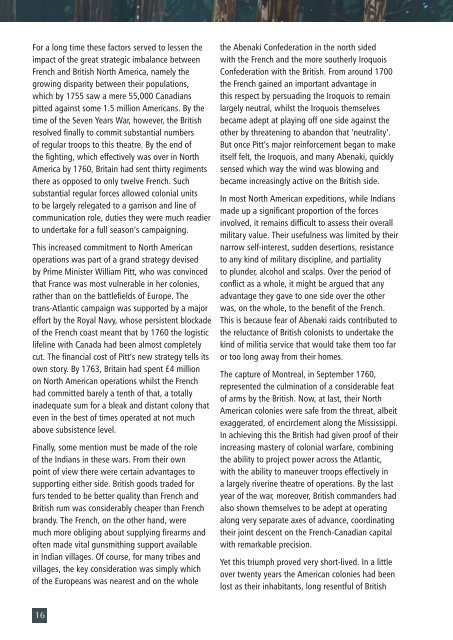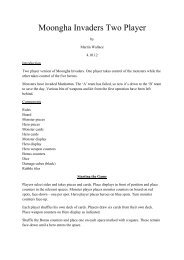A Few Acres Of Snow â 2nd Edition Rules (PDF) - Treefrog Games
A Few Acres Of Snow â 2nd Edition Rules (PDF) - Treefrog Games
A Few Acres Of Snow â 2nd Edition Rules (PDF) - Treefrog Games
You also want an ePaper? Increase the reach of your titles
YUMPU automatically turns print PDFs into web optimized ePapers that Google loves.
For a long time these factors served to lessen the<br />
impact of the great strategic imbalance between<br />
French and British North America, namely the<br />
growing disparity between their populations,<br />
which by 1755 saw a mere 55,000 Canadians<br />
pitted against some 1.5 million Americans. By the<br />
time of the Seven Years War, however, the British<br />
resolved finally to commit substantial numbers<br />
of regular troops to this theatre. By the end of<br />
the fighting, which effectively was over in North<br />
America by 1760, Britain had sent thirty regiments<br />
there as opposed to only twelve French. Such<br />
substantial regular forces allowed colonial units<br />
to be largely relegated to a garrison and line of<br />
communication role, duties they were much readier<br />
to undertake for a full season’s campaigning.<br />
This increased commitment to North American<br />
operations was part of a grand strategy devised<br />
by Prime Minister William Pitt, who was convinced<br />
that France was most vulnerable in her colonies,<br />
rather than on the battlefields of Europe. The<br />
trans-Atlantic campaign was supported by a major<br />
effort by the Royal Navy, whose persistent blockade<br />
of the French coast meant that by 1760 the logistic<br />
lifeline with Canada had been almost completely<br />
cut. The financial cost of Pitt’s new strategy tells its<br />
own story. By 1763, Britain had spent £4 million<br />
on North American operations whilst the French<br />
had committed barely a tenth of that, a totally<br />
inadequate sum for a bleak and distant colony that<br />
even in the best of times operated at not much<br />
above subsistence level.<br />
Finally, some mention must be made of the role<br />
of the Indians in these wars. From their own<br />
point of view there were certain advantages to<br />
supporting either side. British goods traded for<br />
furs tended to be better quality than French and<br />
British rum was considerably cheaper than French<br />
brandy. The French, on the other hand, were<br />
much more obliging about supplying firearms and<br />
often made vital gunsmithing support available<br />
in Indian villages. <strong>Of</strong> course, for many tribes and<br />
villages, the key consideration was simply which<br />
of the Europeans was nearest and on the whole<br />
the Abenaki Confederation in the north sided<br />
with the French and the more southerly Iroquois<br />
Confederation with the British. From around 1700<br />
the French gained an important advantage in<br />
this respect by persuading the Iroquois to remain<br />
largely neutral, whilst the Iroquois themselves<br />
became adept at playing off one side against the<br />
other by threatening to abandon that ‘neutrality’.<br />
But once Pitt’s major reinforcement began to make<br />
itself felt, the Iroquois, and many Abenaki, quickly<br />
sensed which way the wind was blowing and<br />
became increasingly active on the British side.<br />
In most North American expeditions, while Indians<br />
made up a significant proportion of the forces<br />
involved, it remains difficult to assess their overall<br />
military value. Their usefulness was limited by their<br />
narrow self-interest, sudden desertions, resistance<br />
to any kind of military discipline, and partiality<br />
to plunder, alcohol and scalps. Over the period of<br />
conflict as a whole, it might be argued that any<br />
advantage they gave to one side over the other<br />
was, on the whole, to the benefit of the French.<br />
This is because fear of Abenaki raids contributed to<br />
the reluctance of British colonists to undertake the<br />
kind of militia service that would take them too far<br />
or too long away from their homes.<br />
The capture of Montreal, in September 1760,<br />
represented the culmination of a considerable feat<br />
of arms by the British. Now, at last, their North<br />
American colonies were safe from the threat, albeit<br />
exaggerated, of encirclement along the Mississippi.<br />
In achieving this the British had given proof of their<br />
increasing mastery of colonial warfare, combining<br />
the ability to project power across the Atlantic,<br />
with the ability to maneuver troops effectively in<br />
a largely riverine theatre of operations. By the last<br />
year of the war, moreover, British commanders had<br />
also shown themselves to be adept at operating<br />
along very separate axes of advance, coordinating<br />
their joint descent on the French-Canadian capital<br />
with remarkable precision.<br />
Yet this triumph proved very short-lived. In a little<br />
over twenty years the American colonies had been<br />
lost as their inhabitants, long resentful of British<br />
16











